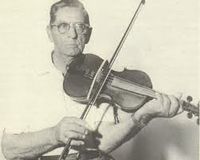Annotation:Valse à Napoleon (1): Difference between revisions
No edit summary |
No edit summary |
||
| Line 7: | Line 7: | ||
</font></p> | </font></p> | ||
<p><font face="garamond, serif" size="4"> | <p><font face="garamond, serif" size="4"> | ||
''Source for notated version'': Dennis McGee (La.) [Francois]. | ''Source for notated version'': Dennis McGee (1893-1989, Eunice, La.) [Francois]. | ||
<br> | <br> | ||
<br> | <br> | ||
Revision as of 18:21, 7 April 2013
Back to Valse à Napoleon (1)
VALSE À NAPOLEON [1] (Napoleon's Waltz). Cajun, Waltz and Two-Step. USA, Louisiana. C Major ('A' part) & G Major ('B' part). Standard tuning (fiddle). AAB. Francois' source, Cajun fiddler Dennis McGee, claims the tune was played by a general in response to part of the last request of a condemned soldier by the name of Guilbeau. Just before being executed by a firing squad Guilbeau asked to play the fiddle and speak. The request being granted and handcuffs removed, he proceeded to play "Guilbeau's Waltz" and when he was done he asked the general to play a tune, "Napoleon's Waltz." McGee believes this incident happened during the Civil War. See also "Guilbeau's Waltz" and also tunes with similar "condemned fiddler" legends attached: "Camp Chase (2)," "MacPherson's Lament," "Last of Callahan."
Source for notated version: Dennis McGee (1893-1989, Eunice, La.) [Francois].

Printed sources: Francois (Yé Yaille, Chère!), 1990; p. 235.
Recorded sources: Swallow Records SW-6030, Dennis McGee.
Back to Valse à Napoleon (1)
